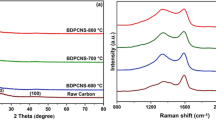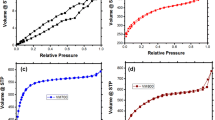Abstract
Using the facile method of solvent evaporation, the leonardite fulvic acids (LFA)-based porous carbon microbeads (PCM) have been successfully prepared at ambient pressure, followed by carbonization and KOH activation (a low mass ratio alkali/LFA = 1.5) in an inert atmosphere. The effects of KOH treatment on pore structures and the formation mechanism of the PCM were discussed. The results showed that the sample exhibited remarkable improvement in textural properties. The activated carbon microbeads had high surface area (2269 m2 g−1), large pore volume (1.97 cm3 g−1), and displayed excellent capacitive performances, compared with carbon powder. The porous carbon material electrodes with the “porous core structure” behaved superiorly at a specific capacitance of 320 F g−1 at a current density of 0.05 A g−1 in 6 M KOH electrolyte, which could still remain 193 F g−1 when the current density increased to 100 A g−1. Remarkably, in the 1 M TEABF4/PC electrolyte, the PCM samples could reach 156 F g−1 at 0.05 A g−1, possess an outstanding energy density of 39.50 Wh kg−1, and maintain at 22.05 Wh kg−1 even when the power density rose up to 5880 W kg−1. The balance of structural characteristic and high performance makes the porous carbon microbeads a competitive and promising supercapacitor electrode material.








Similar content being viewed by others
References
Tang J, Liu J, Li CL, Li YQ, Tade MO, Dai S, Yamauchi Y (2015a) Synthesis of nitrogen-doped mesoporous carbon spheres with extra-large pores through assembly of diblock copolymer micelles. Angew Chem Int Ed 54:588–593
Tang J, Salunkhe RR, Liu J, Torad NL, Imura M, Furukawa S, Yamauchi Y (2015b) Thermal conversion of core−shell metal−organic frameworks: a new method for selectively functionalized nanoporous hybrid carbon. J Am Chem Soc 1377:1572–1580
Li FB, Qian QL, Yan F, Yuan GQ (2006) Nitrogen-doped porous carbon microspherules as supports for preparing monodisperse nickel nanoparticles. Carbon 44:128–132
Torad NL, Hu M, Ishihara S, Sukegawa H, Belik AA, Imura M, Ariga K, Sakka Y, Yamauchi Y (2014) Direct synthesis of MOF-derived nanoporous carbon with magnetic Co nanoparticles toward efficient water treatment. Small 10:2096–2107
Zarifi MH, Fayaz M, Goldthorp J, Abdolrazzaghi M, Hashisho Z, Daneshmand M (2015) Microbead-assisted high resolution microwave planar ring resonator for organic-vapor sensing. Appl Phys Lett 106:062903-1–062903-4
Ansón-Casaos A, Sampaio MJ, Jarauta-Córdoba C, Martínez MT, Silva CG, Faria JL, Silva AMT (2015) Evaluation of sol–gel TiO2 photocatalysts modified with carbon or boron compounds and crystallized in nitrogen or air atmospheres. Chem Eng J 277:11–20
Kim C, Fujino T, Miyashita K, Hayashi T, Endozand M, Dresselhausb MS (2000) Microstructure and electrochemical properties of boron-doped mesocarbon microbeads. J Electro Chem Soc 147:1257–1264
Liao LX, Zuo PJ, Ma YL, An YX, Yin GP, Gao YZ (2012) Effects of fluoroethylene carbonate on low temperature performance of mesocarbon microbeads anode. Electrochim Acta 74:260–266
Yang SB, Song HH, Chen XH (2006) Electrochemical performance of expanded mesocarbon microbeads as anode material for lithium-ion batteries. Electrochem Commun 8:137–142
Xia KS, Gao QM, Jiang JH, Hu J (2008) Hierarchical porous carbons with controlled micropores and mesopores for supercapacitor electrode materials. Carbon 46(13):1718–1726
Han Y, Dong XT, Zhang C, Liu SX (2012) Hierarchical porous carbon hollow-spheres as a high performance electrical double-layer capacitor material. J Power Sources 211:92–96
Wang GQ, Wang DL, Kuang S, Xing W, Zhuo SP (2014) Hierarchical porous carbon derived from rice husk as a low-cost counter electrode of dye-sensitized solar cells. Renew Energy 63:708–714
Guan C, Zhang X, Wang K, Yang C (2009) Investigation of H2 storage in a templated carbon derived from zeolite Y and PFA. Sep Purif Technol 66(3):565–569
Stevenson FJ (1994) Humus chemistry: genesis, composition, reactions, seconded. Wiley, New York
Qiao ZJ, Chen MM, Wang CY (2014) Humic acids-based hierarchical porous carbons as high-rate performance electrodes for symmetric supercapacitors. Bioresour Technol 163:386–389
Chen M, Yu C, Liu SH, Fan X, Zhao X, Qiu JS (2015a) Micro-sized porous carbon spheres with ultra-high rate capability for lithium storage. Nanoscale 7:1791–1795
He XJ, Zhang HB, Zhang H, Li XJ, Xiao N, Qiu JS (2014) Direct synthesis of 3D hollow porous graphene balls from coal tar pitch for high performance supercapacitors. J Mater Chem A 2:19633–19640
Lorenc-Grabowska E, Gryglewicz G (2005) Adsorption of lignite-derived humic acids on coal-based mesoporous activated carbons. J Colloid Interface Sci 284:416–423
Wasiński K, Walkowiak M, Lota G (2014) Humic acids as pseudocapacitive electrolyte additive for electrochemical double layer capacitors. J Power Sources 255:230–234
Chen WX, Zhang H, Huang YQ, Wang WK (2010) A fish scale based hierarchical lamellar porous carbon material obtained using a natural template for high performance electrochemical capacitors. J Mater Chem 20:4773–4775
Jones MN, Bryan ND (1998) Colloidal properties of humic substances. Adv Colloid Interfac 78(1):1–48
Shrestha LK, Shrestha RG, Yamauchi Y, Hill JP, Nishimura T, Miyazawa K, Kawai T, Okada S, Wakabayashi K, Ariga K (2015) Nanoporous carbon tubes from fullerene crystals as the π-electron carbon source. Angew Chem Int Ed 54:951–955
Rajbhandari R, Shrestha LK, Bhadra BP, Pradhananga RR (2013) Development of Nanoporous Structure in Carbons by Chemical Activation with Zinc Chloride. J Nanosci Nanotechnol 13:2613–2623
Guo Y, Shi ZQ, Chen MM, Wang CY (2014) Hierarchical porous carbon derived from sulfonated pitch for electrical double layer capacitors. J Power Sources 252:235–243
Wang H, Xu Z, Kohandehghan A, Li Z, Cui K, Tan X, et al. (2013a) Interconnected carbon nanosheets derived from hemp for ultrafast supercapacitors with high energy. ACS Nano 7:5131–5141
Fujii M, Yamada Y, Imamura T (1987) Preparation of aqua-mesophase by nitration or sulfonation of carbonaceous mesophase and properties of carbon material made from it. 18th Biennial Conference of Carbon 405–406.
Michio I, Hidetaka K, Osamu T (2010) Carbon materials for electrochemical capacitors. J Power Sources 195(24):7880–7903
Salunkhe RR, Tang J, Kamachi Y, Nakato T, Kim JH, Yamauchi Y (2015) Asymmetric supercapacitors using 3D nanoporous carbon and cobalt oxide electrodes synthesized from a single metal-organic framework. ACS Nano 9:6288–6296
Salunkhe RR, Kamachi Y, Torad NL, Hwang SM, Sun ZQ, Dou SX, Kim JH, Yamauchi Y (2014) Fabrication of symmetric supercapacitors based on MOF derived nanoporous carbons. J Mater Chem A 2:19848–19854
Zhai Y, Dou Y, Zhao D, Fulvio PF, Mayes RT, Dai S (2011) Carbon materials for chemical capacitive energy storage. Adv Mater 23:4828–4850
Adhikari MP, Adhikari R, Shrestha RG, Rajendran R, Adhikari L, Bairi P, Pradhananga RR, Shrestha LK, Ariga K (2015) Nanoporous activated carbons derived from agro-waste corncob for enhanced electrochemical and sensing performance. Bull Chem Soc Jpn 88:1108–1115
Zhao NQ, Wu S, He CN, Shi CS, Liu EZ, Du XW, et al. (2012) Hierarchical porous carbon with graphitic structure synthesized by a water soluble template method. Mater Lett 87:77–79
Antonio MS, Fuertes B (2014) Direct synthesis of highly porous interconnected carbon nanosheets and their application as high performance supercapacitors. ACS Nano 5:5069–5078
Rodil SE, Ferrari AC, Robertson J, Milne WI (2001) Raman and infrared modes of hydrogenated amorphous carbon nitride. J Appl Phys 89:5425–5430
Sheng C (2007) Char structure characterised by Raman spectroscopy and its correlations with combustion reactivity. Fuel 86:2316–2324
Wang JZ, Chen MM, Wang CY, Wang J, Zheng JM (2012) A facile method to prepare carbon aerogels from amphiphilic carbon material. Mater Lett 68:446–449
Yuan YC, Zhang C, Wang CY, Chen MM (2015a) Amphiphilic carbonaceous material-based hierarchical porous carbon aerogels for supercapacitors. J Solid State Electrochem 19:619–627
Li YT, Pi YT, Lu LM, Xu SH, Ren TZ (2015) Hierarchical porous active carbon from fallen leaves by synergy of K2CO3 and their supercapacitor performance. J Power Sources 299:519–528
Xiang Z, Cao D, Huang L, Shui J, Wang M, Dai L (2014) Nitrogen-doped holey graphitic carbon from 2D covalent organic polymers for oxygen reduction. Adv Mater 26(20):3315–3320
Guo Y, Rockstraw DA (2007) Activated carbons prepared from rice hull by one-step phosphoric acid activation. Microporous Mesoporous Mater 100:504–512
White RJ, Budarin V, Luque R, Clark JH, Macquarrie D (2009) Tuneable porous carbonaceous materials from renewable resources. Chem Soc Rev 38:3401–3418
Wu XL, Wen T, Guo HL, Yang SB, Wang XK, Xu AW (2013) Biomass-derived sponge-like carbonaceous hydrogels and aerogels for supercapacitors. ACS Nano 4:3589–3597
Lin ZJ, Hu XB, et al. (2010) Preparation and characterization of a new carbonaceous material for electrochemical systems. J Serb Chem Soc 75:271–282
Liu HJ, Wang J, Wang CX, Xia YY (2011) Ordered hierarchical mesoporous/microporous carbon derived from mesoporous titanium-carbide/carbon composites and its electrochemical performance in supercapacitor. Adv Energy Mater 1:1101–1108
Kundu S, Nagaiah TC, Xia W, Wang Y, Dommele SV, Bitter JH, et al. (2009) Electrocatalytic activity and stability of nitrogen-containing carbon nanotubes in the oxygen reduction reaction. J Phys Chem C 113(32):14302–14310
Aijaz A, Fujiwara N, Xu Q (2014) From metal-organic framework to nitrogen-decorated nanoporous carbons: superior CO2 uptake and highly efficient catalytic oxygen reduction. J Am Chem Soc 136(19):6790–6793
Zhong S, Zhan CX, Cao DP (2015) Zeolitic imidazolate framework-derived nitrogen-doped porous carbons as high performance supercapacitor electrode material. Carbon 85:51–59
Chen AB, Yu YF, Xing TT, Wang RJ, Li YL, Li YT (2015b) Synthesis of nitrogen-doped hierarchical porous carbon for supercapacitors. Mater Lett 157:30–33
Zhao QL, Wang XY, Xia H, Liu J, Wang H, Gao J, et al. (2015) Design, preparation and performance of novel three-dimensional hierarchically porous carbon for supercapacitors. Electrochim Acta 173:566–574
Han T, Park MS, Kim JH, Kim JH, Kim K (2016) The smallest quaternary ammonium salts with ether groups for high performance electrochemical double layer capacitors. Chem Sci 7:1791–1796
Lv YK, Gan LH, Liu MX, Xiong WZ, Xu J, Zhu DZ, et al. (2012) A self-template synthesis of hierarchical porous carbon foams based on banana peel for supercapacitor electrodes. J Power Sources 209:152–157
Ma GF, Yang Q, Sun KJ, Peng H, Ran FT, Zhao XL, Lei ZQ (2015) Nitrogen-doped porous carbon derived from biomass waste for high-performance supercapacitor. Bioresour Technol 197:137–142
Huang WT, Zhang H, Huang YQ, Wang WK, Wei SC (2011) Hierarchical porous carbon obtained from animal bone and evaluation in electric double-layer capacitors. Carbon 49(23):838–843
Andrian EI, Steven WE, Felycia S, Suryadi I (2010) Preparation of capacitor’s electrode from cassava peel waste. Bioresour Technol 101(10):3534–3540
Jiao Y, Zhang DY, Zhao ZQ, Wang XL, Zhu H, Wang CY (2014) Meso- and micro- porous composite carbons derived from humic acid for supercapacitors. Electrochim Acta 136:504–512
Zolfaghari A, Naderi HR, Mortaheb HR (2013) Carbon black/manganese dioxide composites synthesized by sonochemistry method for electrochemical supercapacitors. J Electroanal Chem 697:60–67
Basri NH, Deraman M, Kanwal S, Talib IA, Manjunatha JG, Aziz AA, et al. (2013) Supercapacitors using binderless composite monolith electrodes from carbon nanotubes and pre-carbonized biomass residues. Biomass Bioenergy 59:370–379
Li FJ, Morris M, Chan KWY (2011) Electrochemical capacitance and ionic transport in the mesoporous shell of a hierarchical porous core–shell carbon structure. J Mater Chem 21(24):8880–8886
Simon P, Gogotsi Y (2008) Materials for electrochemical capacitors. Nat Mater 7:845–854
Yuan K, Xu Y, Uihlein J, Brunklaus G, Shi L, Ralf H, et al. (2015b) Straightforward generation of pillared microporous graphene frameworks for use in supercapacitors. Adv Mater 27:6714–6721
Zhu H, Wang XL, Yang F, Yang XR (2011) Promising carbons for supercapacitors derived from fungi. Adv Mater 23:2745–2748
Wang H, Xu Z, Kohandehghan A, Li Z, Cui K, Tan X (2013b) Interconnected carbon nanosheets derived from hemp for ultrafast supercapacitors with high energy. ACS Nano 7:5131–5141
Acknowledgments
This study was supported by the National Natural Science Foundation of China (NSFC 51172160).
Author information
Authors and Affiliations
Corresponding author
Rights and permissions
About this article
Cite this article
Ma, Yz., Yu, Bj., Guo, Y. et al. Facile synthesis of biomass-derived hierarchical porous carbon microbeads for supercapacitors. J Solid State Electrochem 20, 2231–2240 (2016). https://doi.org/10.1007/s10008-016-3233-4
Received:
Revised:
Accepted:
Published:
Issue Date:
DOI: https://doi.org/10.1007/s10008-016-3233-4




